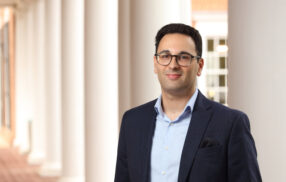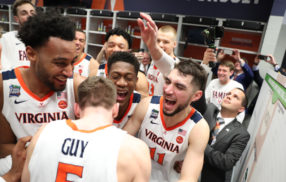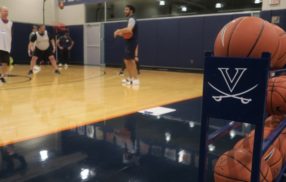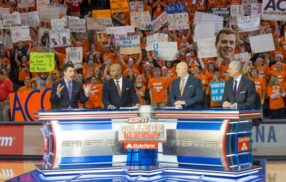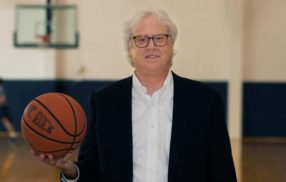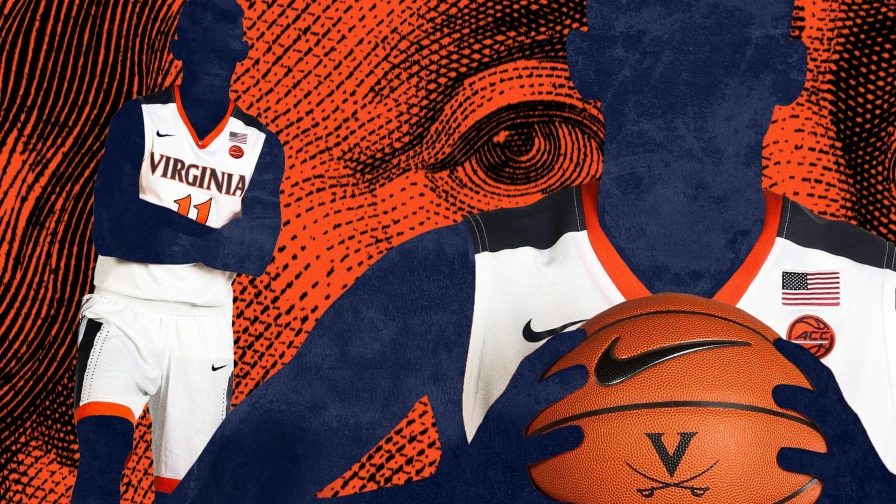
UVA Darden Professor Teams With Hoops Stars to Create ‘NIL’ Workbook
By Whitelaw Reid
For years, it was ingrained in student-athletes to say “no” to the car dealership that invited them to their grand opening, the pizza place that wanted them to wear their T-shirt, the sports memorabilia store that wanted their autographs, and even the local elementary school or hospital that was planning a fundraiser.
A failure to say “no” could result in massive NCAA penalties, including ineligibility, suspensions, forfeiture of games and vanquishing of championships.
Now, new NCAA rules that allow student-athletes to say “yes” have changed the entire landscape of college athletics. The rule change – prompted by a change in state law in several states – took effect in July.
For the student-athletes, who are now permitted to profit financially off their name, image and likeness – known as “NIL” opportunities – it is an exciting time. However, with new opportunities come risks.
That’s where University of Virginia Darden School of Business Professor Kim Whitler comes in.
An expert in marketing and brand strategy, Whitler and McIntire School of Commerce alumnus Jay Hodgkins are creating a self-guided workbook that is geared specifically for UVA student-athletes who will be navigating tricky new terrain.
The book, written in partnership with UVA Athletics via a grant from Darden Dean Scott Beardsley, has a working title of “Designing, Activating, and Monetizing Your Athlete Brand.”
Available in the spring, the book will walk UVA’s 750 student-athletes through four steps: one, setting a vision/goals; two, designing your brand; three, activating your brand; and four, monetizing your brand.
Whitler said the concept came from conversations she had with Ted White, UVA’s deputy athletics director for strategic advancement, in which she championed the idea of “teaching the student-athletes to fish, rather than giving them a fish.”
White said Whitler was the perfect person to help guide not just the student-athletes, but the athletic department as a whole through uncharted waters.
“She’s an incredibly talented expert in her field, so I knew she could help us analyze the landscape and come up with a strategy that would help each of our students take advantage of short-term opportunities, while protecting their long-term interests,” White said. “More importantly though, what I quickly learned was that our philosophies were completely aligned and that she is an incredibly generous person.
“Kim took a seed of an idea, assembled a terrific team, involved current and former student-athletes, and produced an invaluable resource in an absurdly tight window of time. As a result, UVA student-athletes will have access to the best content available, developed specifically for them by someone who truly has their best interests in mind – both short-term and long-term.”
In writing the workbook, Whitler complemented her years of field and research experience with feedback from a number of former UVA student-athletes, including men’s basketball stars Ty Jerome and Kyle Guy (both now in the NBA) and basketball walk-ons Thomas Rogers and Grant Kersey.
White said the genius of the book is in its engaging format, but the beauty of the book is in its scalability.
“That combination means every single student-athlete has access to Kim’s expertise, yet can create their own personalized experience,” White said.
Whitler, who also has another book centered on brand strategy, Positioning For Advantage, that just hit the shelves – sat down with UVA Today to explain more about the endeavor.
As it relates to name, imaging and licensing opportunities, what did you mean exactly when you told Ted White that you believed UVA student-athletes needed to learn to fish first?
Ted reached out to see what I thought about the number of different marketing agencies that wanted to provide services [for student-athletes] for a fee.
As a former chief marketing officer, there are three potential issues that worried me about working with agencies. One is that they aren’t all equally competent. The second is that many of the agencies are tactical; what this means is that they will start with an activity (e.g., social media) and start trying to publicize the athlete. Brand building, however, starts with designing and activating a brand that is worthy of monetization. That requires putting brand strategy before tactics. The third issue is that not all agencies have the students’ best interests in mind. Just look at the legal battle that [former Duke University basketball player] Zion Williamson got into with an organization that appears to have taken advantage of his youth and inexperience.
As we discussed these concerns, Ted and I were of a like mind: Was there a “UVA way” to help educate our student-athletes that would empower them to understand the basics of brand-building so that it could help them achieve their goals?
The more we talked about what was possible, the more excited we got. What if we gave students “agency” to understand how to think about and activate their own brands? For those students who end up in professional athletic careers, this would better prepare them to take ownership over their brands and lead their support team to achieve what the athlete wants. For those who pursue more traditional, non-sports-related careers after school, this would enable them to think about how to build their own professional brands in a way that helps them achieve their career goals.
This is an approach that completely aligns with UVA’s mission and one that Ted and I thought was better suited for the educational excellence that UVA provides. It also provides a different, more holistic approach than what many other schools are delivering.
What, in your opinion, does the ideal NIL deal look like for a student-athlete? And on the flip side, what would be an example of a bad deal? What are some risks that student-athletes should try and avoid?
This comes back to each individual’s personal goals. There is no “one-size-fits-all.”
Consider Ty Jerome as one example. He had a very clear vision to get to the NBA and have a long career, even though many did not consider him an NBA-level talent when he arrived at UVA. He has constrained resources, the most precious for students being “time.” How he allocates his resources (e.g., time) to achieve his goals is a strategic decision. So what would be Ty’s best use of time, given his goals? Investing in anything related to basketball.
That might mean minimizing NIL efforts that don’t support improving his basketball knowledge and skill and reducing any risk associated with NIL activities. He might have chosen to spend 30 minutes after home games signing autographs (and getting paid for it) and that might have been the extent to which he invested in monetization efforts. Signing autographs is far less risky than, say, social media, where one comment can derail an athlete’s brand.
Whitler encourages student-athletes to identify their “superpower.” (Contributed photo)
So, the answer to your question is that the “ideal” NIL deal is the one that helps each student-athlete achieve their dreams. Each NIL tactic (e.g., camps, lessons, work product, social media, autograph signing, endorsements, and so forth) has different pros and cons – just like each marketing channel. Strategically, you want to align your tactical choices with your brand strategy and objectives.
There will be endless ways for student-athletes to make money. Without direction and an alignment with their goals, they are at risk of wasting time chasing opportunities down rabbit holes – and the consequence is that they fail to achieve their goals.
That’s why the approach we have taken in this book is to go through the goal- and vision-setting, resource allocation, brand design and activation plan before venturing into how to integrate monetization. It is a strategy-first approach that anchors monetization on each individual student-athlete’s goals.
Why do you think partnering with student-athletes can be a good marketing strategy for companies?
One benefit for companies is that these emerging athlete brands can be far less expensive than a well-known athlete like Serena Williams. I think that an undervalued benefit is that by connecting with beloved university athlete brands – like [UVA swimmers and Olympic medalists] Paige Madden or Alex Walsh or [basketball players] Ty Jerome or De’Andre Hunter or Kyle Guy or Kihei Clark or [soccer star] Rebecca Jarrett or [football star] Charles Snowden – large brands, like Olay or Dove or Gillette, can connect with the deep emotion that collegiate fans have for their school. Rather than plastering a logo on the side of an ice rink or arena, these brands are committing to support “our” university’s student-athletes.
Some might wonder why a large national or global brand would care about partnering with essentially local or regional celebrities, but the trend in marketing for years, thanks to social media, big data and the overall digital marketing revolution, has been toward personalized marketing over mass marketing. I think the deep passion that fans have for their school and their student-athletes may then spill over to the sponsoring brands.
Another benefit of sponsoring younger athletes is developing relationships early so that the athletes are more inclined to continue partnering as their athlete brands grow. Essentially, the companies are placing small bets, building a pipeline of athletes in hopes a few develop huge pro athlete brands.
In one of the exercises in the workbook, you ask student-athletes to identify their “superpower.” Can you explain what you mean by this and how this ties in with designing their own personal brands?
Each person has a strength, something that they excel in. Identifying your “superpower” is about understanding what your essential strength is – the value that you uniquely contribute to your team or to an organization.
For example, I just worked with a group of senior military leaders. We were going through this exercise to help them develop their “G-Level” (general level) brands. Whether it is an executive or a military leader or a student-athlete, you want to know what your contribution and impact is so you can build your brand around this “asset.”
From my perspective as a fan, I viewed Ty Jerome as a “gritty winner.” He outworked others and generally found a way to help lead his team to victory. He overcame any and all limitations with the heart of a lion to fearlessly “never give up” and “find a better way.” If you go back and view many of his post-game interviews and the summaries of his interviews given during the NBA Combine and throughout the draft process, a common theme was around “finding a way to win.”
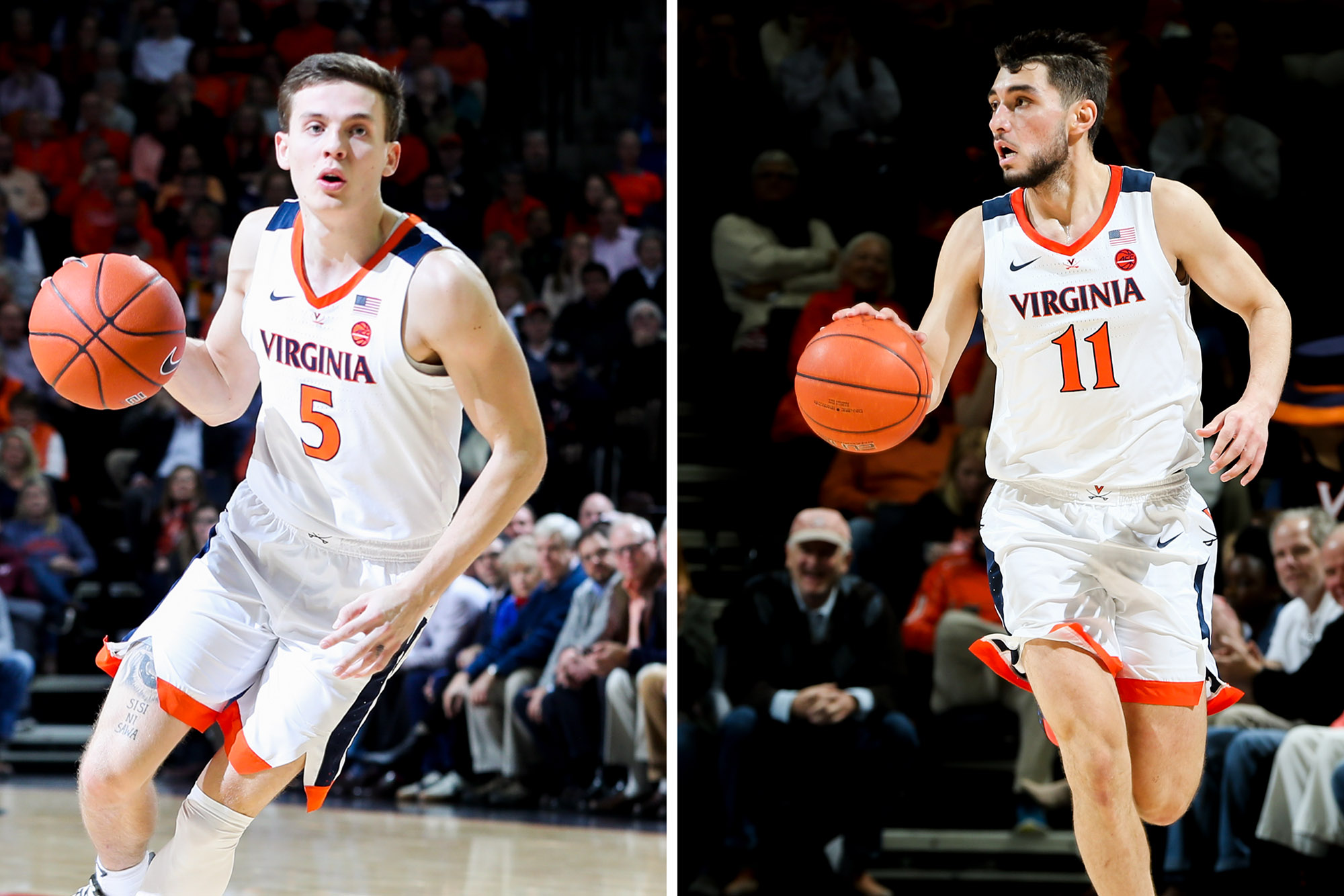
Former Cavalier basketball players Kyle Guy, left, and Ty Jerome have played important roles in the creation of the workbook. (Photos by Matt Riley, University Athletics)
By the way, this consistency of activation – consistently reinforcing his “brand” – is important. There is a reason why Coca-Cola reinforces its “refreshing” properties or Tide reminds everybody decade after decade that “if it’s got to be clean, it’s got to be Tide.” When you have identified a powerful strategy, you want to reinforce it. Ty did this naturally. He was consistent across his interviews and throughout the draft process. He knew who he was, how he could help teams, and was able to articulate this effectively to the teams interviewing him. Consequently, his stock went up during the draft process. He “wowed” people during interviews because he knew his superpower, had spent years cultivating it (i.e., “activating it”), and then was able to communicate it effectively.
This is no different than Wegman’s or Pepsi or Tide having a clear brand strategy, activating it consistently through actions and behavior, and then communicating it.
Can you talk a little bit about the incredible cooperation from all the former UVA student-athletes? Does it say a lot that they were so willing to help out with something that can no longer benefit them?
I work almost exclusively with MBA students, so this has been a terrific opportunity to get to know our current and former student-athletes. This all started with Darden alumni Mamadi Diane and Thomas Rogers, who believe that there is talent across the campus that can benefit the athletic department. Thomas has been involved in the project from the beginning, as has Grant Kersey. Thomas recently helped Jay and I refine the title and Grant has been instrumental in helping us develop examples for the different exercises.
I interviewed a number of student-athletes before writing the book; one was Rebecca Jarrett, one of our outstanding soccer players. After the interview, I offered to help her in any way I could and she called me in March and said she was interested in marketing and would like to learn.
I am still amazed at her. Think about her stepping forward months later and saying, “I’ll take you up on your offer and want to learn.” She came aboard, and it has been terrific to have her involvement, because she “sees things differently.” (That is part of her brand). She is quite visual and helped us evolve some of the exercises to better help students visualize the activity.
Liam Nolan is a second-year who is a sports enthusiast and analyst. He worked full-time this past summer, thanks to a grant from Dean Beardsley, and has been extremely helpful in conducting background research for the book. He formatted all of the references and has helped edit sections throughout the process to ensure our tone was right for students.
Finally, I have to mention Ty and Kyle. Both have been extremely helpful in reading through excerpts and working with Grant so that we can use them as high-profile examples. What I’ve learned through this process is that they have a “UVA” spirit to give back and help our future student-athletes as much as possible. As somebody who has admired them from afar – and has been a fan of Kyle’s before he even arrived (I got my Ph.D. at Indiana University, so was very happy to land Indiana’s Mr. Basketball), I have been really impressed.
Despite their incredible success (and frankly their busy schedules), when nobody is looking, people like Ty, Kyle, Grant, Becca and Thomas have been exceptionally willing to help. Anybody who has watched our athletes will not be surprised, but they definitely deserve credit for caring about the program and being instrumental in giving back in a “behind-the-scenes” way that doesn’t garner attention. Jay and I could not have written this book without the participation and help from all of these current and former students. On top of it, our ability to publish this on an accelerated timeline is only possible because Steve Momper, head of Darden Publishing, is moving mountains to try and parallel path activities that normally are done sequentially.
Since your book won’t be available until the spring, any other quick tips for UVA student-athletes who are already navigating this new frontier?
First, focus on your goals. Don’t let the possibility of making money distract you from achieving your goals. My primary worry is that student-athletes get derailed from accomplishing their dreams because they become attracted to making a fast dollar.
There is a saying that goes something like, “Don’t step over $1 to pick up a nickel.” If you think about Ty, had he focused on making even $100,000 per year, he might have missed out on the opportunity to make millions per year and achieve his long-term goals.
Second, be strategic about your resource allocation. That means spending your time in a way that aligns with your goals and long-term vision. If you want to compete in the Olympics, then don’t allow monetization to be a distraction. If you want to or need to make a lot of immediate money, then invest in monetization activities that align with your other goals.
Third, protect your brand. I’m not a lawyer, but in the early days, there will be a lot of snake oil salesmen who may try and lock student-athletes into contracts that are one-sided. Get some advice from a lawyer before signing a contract. If it seems “too good to be true” it probably is.
Fourth, try and identify what your superpower is. Know “you.” A good way to figure this out is to ask those who know you well – coaches, peers, family, friends. The clearer you are about who you are and what you uniquely contribute to the team – on and off the field – the better able you are to assess opportunities and to ensure that any pursue are consistent with your brand.
Part of this is being honest with yourself. I played collegiate golf, but was never going to be a top-10 global player. At the time I went to college, you essentially had to be at the top to make any money as a female golfer. Consequently, I used my free education to prepare me for a traditional career. I was honest with myself about my limitations and that enabled me to think strategically about how to leverage the gift of a free education to chart a different future.
Finally, remember we are in the early days of NIL. There are opportunists everywhere. It is a bit like the gold rush. Ted, Jay, and I really hope to empower student-athletes with knowledge and skills that can benefit them – no matter where they go in the future.
The University of Virginia Darden School of Business prepares responsible global leaders through unparalleled transformational learning experiences. Darden’s graduate degree programs (MBA, MSBA and Ph.D.) and Executive Education & Lifelong Learning programs offered by the Darden School Foundation set the stage for a lifetime of career advancement and impact. Darden’s top-ranked faculty, renowned for teaching excellence, inspires and shapes modern business leadership worldwide through research, thought leadership and business publishing. Darden has Grounds in Charlottesville, Virginia, and the Washington, D.C., area and a global community that includes 18,000 alumni in 90 countries. Darden was established in 1955 at the University of Virginia, a top public university founded by Thomas Jefferson in 1819 in Charlottesville, Virginia.
Press Contact
Molly Mitchell
Senior Associate Director, Editorial and Media Relations
Darden School of Business
University of Virginia
MitchellM@darden.virginia.edu



